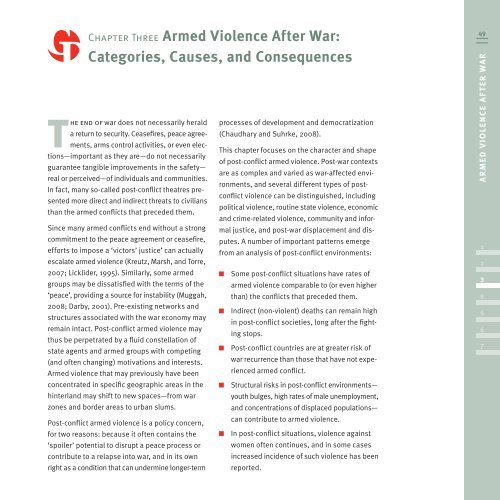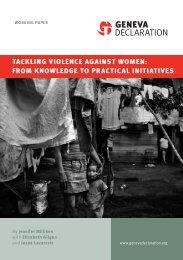Global Burden of Armed Violence - The Geneva Declaration on ...
Global Burden of Armed Violence - The Geneva Declaration on ...
Global Burden of Armed Violence - The Geneva Declaration on ...
Create successful ePaper yourself
Turn your PDF publications into a flip-book with our unique Google optimized e-Paper software.
Chapter Three <str<strong>on</strong>g>Armed</str<strong>on</strong>g> <str<strong>on</strong>g>Violence</str<strong>on</strong>g> After War:<br />
Categories, Causes, and C<strong>on</strong>sequences<br />
<str<strong>on</strong>g>The</str<strong>on</strong>g> end <str<strong>on</strong>g>of</str<strong>on</strong>g> war does not necessarily herald<br />
a return to security. Ceasefires, peace agree-<br />
ments, arms c<strong>on</strong>trol activities, or even elec-<br />
ti<strong>on</strong>s—important as they are—do not necessarily<br />
guarantee tangible improvements in the safety—<br />
real or perceived—<str<strong>on</strong>g>of</str<strong>on</strong>g> individuals and communities.<br />
In fact, many so-called post-c<strong>on</strong>flict theatres pre-<br />
sented more direct and indirect threats to civilians<br />
than the armed c<strong>on</strong>flicts that preceded them.<br />
Since many armed c<strong>on</strong>flicts end without a str<strong>on</strong>g<br />
commitment to the peace agreement or ceasefire,<br />
efforts to impose a ‘victors’ justice’ can actually<br />
escalate armed violence (Kreutz, Marsh, and Torre,<br />
2007; Licklider, 1995). Similarly, some armed<br />
groups may be dissatisfied with the terms <str<strong>on</strong>g>of</str<strong>on</strong>g> the<br />
‘peace’, providing a source for instability (Muggah,<br />
2008; Darby, 2001). Pre-existing networks and<br />
structures associated with the war ec<strong>on</strong>omy may<br />
remain intact. Post-c<strong>on</strong>flict armed violence may<br />
thus be perpetrated by a fluid c<strong>on</strong>stellati<strong>on</strong> <str<strong>on</strong>g>of</str<strong>on</strong>g><br />
state agents and armed groups with competing<br />
(and <str<strong>on</strong>g>of</str<strong>on</strong>g>ten changing) motivati<strong>on</strong>s and interests.<br />
<str<strong>on</strong>g>Armed</str<strong>on</strong>g> violence that may previously have been<br />
c<strong>on</strong>centrated in specific geographic areas in the<br />
hinterland may shift to new spaces—from war<br />
z<strong>on</strong>es and border areas to urban slums.<br />
Post-c<strong>on</strong>flict armed violence is a policy c<strong>on</strong>cern,<br />
for two reas<strong>on</strong>s: because it <str<strong>on</strong>g>of</str<strong>on</strong>g>ten c<strong>on</strong>tains the<br />
‘spoiler’ potential to disrupt a peace process or<br />
c<strong>on</strong>tribute to a relapse into war, and in its own<br />
right as a c<strong>on</strong>diti<strong>on</strong> that can undermine l<strong>on</strong>ger-term<br />
processes <str<strong>on</strong>g>of</str<strong>on</strong>g> development and democratizati<strong>on</strong><br />
(Chaudhary and Suhrke, 2008).<br />
This chapter focuses <strong>on</strong> the character and shape<br />
<str<strong>on</strong>g>of</str<strong>on</strong>g> post-c<strong>on</strong>flict armed violence. Post-war c<strong>on</strong>texts<br />
are as complex and varied as war-affected envi-<br />
r<strong>on</strong>ments, and several different types <str<strong>on</strong>g>of</str<strong>on</strong>g> post-<br />
c<strong>on</strong>flict violence can be distinguished, including<br />
political violence, routine state violence, ec<strong>on</strong>omic<br />
and crime-related violence, community and infor-<br />
mal justice, and post-war displacement and dis-<br />
putes. A number <str<strong>on</strong>g>of</str<strong>on</strong>g> important patterns emerge<br />
from an analysis <str<strong>on</strong>g>of</str<strong>on</strong>g> post-c<strong>on</strong>flict envir<strong>on</strong>ments:<br />
Some post-c<strong>on</strong>flict situati<strong>on</strong>s have rates <str<strong>on</strong>g>of</str<strong>on</strong>g><br />
armed violence comparable to (or even higher<br />
than) the c<strong>on</strong>flicts that preceded them.<br />
Indirect (n<strong>on</strong>-violent) deaths can remain high<br />
in post-c<strong>on</strong>flict societies, l<strong>on</strong>g after the fight-<br />
ing stops.<br />
Post-c<strong>on</strong>flict countries are at greater risk <str<strong>on</strong>g>of</str<strong>on</strong>g><br />
war recurrence than those that have not expe-<br />
rienced armed c<strong>on</strong>flict.<br />
Structural risks in post-c<strong>on</strong>flict envir<strong>on</strong>ments—<br />
youth bulges, high rates <str<strong>on</strong>g>of</str<strong>on</strong>g> male unemployment,<br />
and c<strong>on</strong>centrati<strong>on</strong>s <str<strong>on</strong>g>of</str<strong>on</strong>g> displaced populati<strong>on</strong>s—<br />
can c<strong>on</strong>tribute to armed violence.<br />
In post-c<strong>on</strong>flict situati<strong>on</strong>s, violence against<br />
women <str<strong>on</strong>g>of</str<strong>on</strong>g>ten c<strong>on</strong>tinues, and in some cases<br />
increased incidence <str<strong>on</strong>g>of</str<strong>on</strong>g> such violence has been<br />
reported.<br />
49<br />
A R M E D V I O L E N C E A F T E R WA R<br />
1<br />
2<br />
3<br />
4<br />
5<br />
6<br />
7









